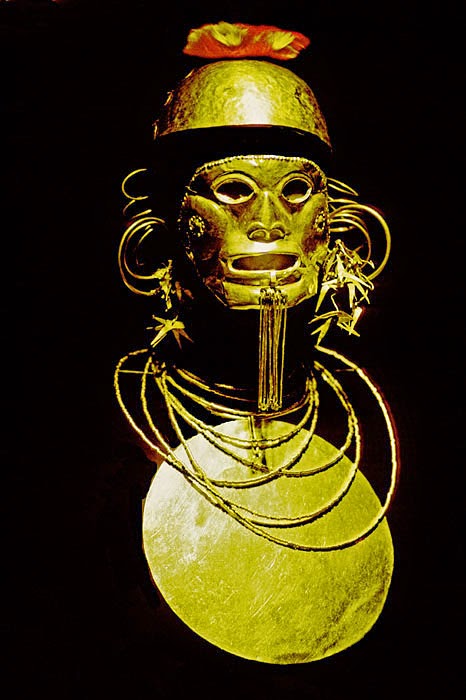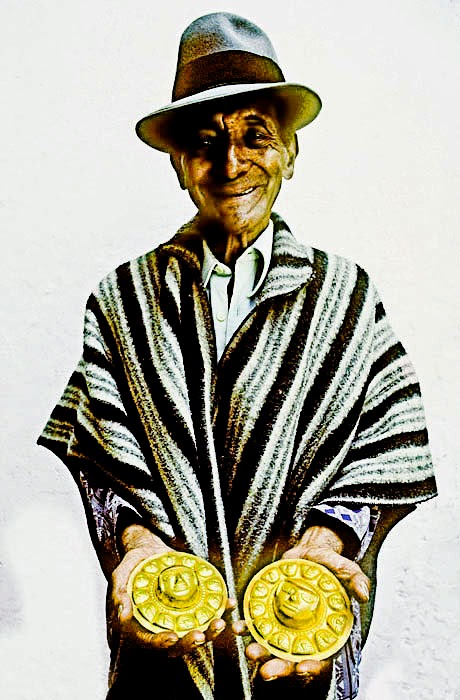At dawn one morning, comforted by a pack of cigarettes and a bottle of aguardiente, a Colombian farmer leaves his mud-brick
house to go treasure hunting. He and four friends identified a possible
pre-Columbian grave site among many others long excavated around it and filled
in again to keep cattle safe. Somewhere in this area of the Calima culture, one
grave had once delivered 18 pounds of gold. But all the best graves have already
been sacked long ago, and expectations are relatively low.
View more photos below the text
--
In 1979, on assignment for Geo, I photographed guaqueros, or grave robbers, in Colombia’s western cordillera as
they excavated a pre-Columbian grave high amid the clouds. Geo is, and remains, a
top German magazine. It also has a French edition, and at the time it had
an American edition as well. Geo titled the story, written by Pat Rotter, Stealing the Gold of El Dorado.
The excavation of the 13-meter deep grave took two long days of hard
work by four men taking turns digging. It would have taken them considerably longer if pre-Colmbian Indians had not already broken the ground before them. Digging out such graves was as illegal in 1979 as it
is today. But there were few archaeologists available to dig the many thousands gold-filled
graves all over the country. Besides, grave robbers were hard to catch, and the
risk of seeing priceless treasures leave the country to foreign collectors had
to be minimized. So the director of the Gold Museum of Bogota, Colombia’s
capital, had no choice but to close his eyes on the theft. This gave him at
least a chance to be the first to examine, and eventually buy, the best pieces
offered to him in total liberty. Ninety percent of the astounding collection of
Bogota’s Gold Museum had been purchased from guaqueros. I don’t know how things
work today.
Colombian archaeologists were not happy with this state of affairs.
While they worked slowly to avoid losing or damaging evidence, greedy uneducated
guaqueros had no such worries. They had to work fast before getting robbed themselves. And in the end they separated
gold from other artifacts, including carbon-bearing ceramic vessels, which
helped to date the graves. But there was little archaeologists could do about
it, other than sometimes work with guaqueros to limit their damages. The fact was that if archaeologists had the science, guaqueros had the uncanny clairvoyance.
Here two of the men inspect the dirt their media cañas plugged out from the site they came to
prospect. Media cañas are half-open cylindrical tools at the end of
two-and-a-half-meter-long poles. Soil is often composed of layers, like black
humus over reddish clay, for instance. However, once pre-Columbian Indians had
excavated the ground to bury a person, the dirt they later threw back into the
grave ended up in mixed colors. The guaqueros looked for mixed soil and found
it. They then kept plugging the ground until finding the exact grave pit's edge.
Taking turns to dig the grave.
Lowering a bucket to be refilled by the man below after having been emptied above.
As the excavation advances, a
manigueta, or hand-turned winch, has been installed to lower a man into it.
It would serve to extricate him from the hole once another man’s turn to dig
would come.
The kneeling man with the striped shirt, Guillermo Cano, directed the
operation. Son and grandson of guaqueros, he himself had sold to the Gold
Museum more than a third of its collection of 28.000 pieces. According to a
1991 article in El Tiempo, a
Colombian newspaper, Guillermo’s grandfather had fallen into a pre-Columbian
grave while repairing a road as an underpaid laborer. That grave, loaded with
18 pounds of gold, had initiated the family’s guaquero tradition. In 1968,
Dory, Guillermo’s wife, started a gallery selling perfect commercial reproductions
of pre-Columbian gold pieces and other jewelry and ornaments. The gallery since then has
multiplied in several Colombian cities. One of Guillermo’s sons is now an
archaeologist.
Working the manigueta.
Six meters below the surface, less than half-way down, the digging man's bent back is hardly visible. The
holes in one of the well’s walls had allowed the ancient Calima excavators to get up
and down it as needed.
To get some of my pictures, I, too, had to go down the pit sometimes. My camera bag traveled down separately.
Finally, as dusk loomed at the end of the second day, the guaqueros touched bottom. They allowed me to quickly go down a last time before they would empty the grave, fearful that other farmers might come and do it during the night. It was so dark down there that I could not see what I was shooting. I also had some trouble breathing. So I blindly shot flash pictures at random all around the grave. This picture here shows the alcove where the body was laid to rest and some of the artifacts that accompanied it. Nested inside the alcove, the dead was not touched by the dirt that was thrown back into the pit after the burial.
As night fell, the grave was quickly emptied. The most exciting piece, taken away too quickly for me to photograph it, had everyone very excited. No one had ever seen anything like it. It was a clay vessel nearly a meter long with a wonderful head—big nose and ears.
Not much gold, however. Only two nose
rings, a thin one and a thick one, the latter weighing five grams. But then,
the grave wasn’t very old--probably from between A.D. 1200 and 1500.
Later in Pasto, in the country’s south, I found more impressive gold
jewelry in the hands of another guaquero.
Then In Bogota, on two different days and shabby hotel rooms, I was
allowed to photograph the man in black buying pre-Columbian antiquities from a guaquero to resell to collectors.
That same man, sitting in the middle of the bed, as he was ready to write a check.
To view more Colombia photos on this blog, write that word in the search
box.
All the
photographs of this blog are copyrighted.
No usage
permitted without prior authorization.
























































